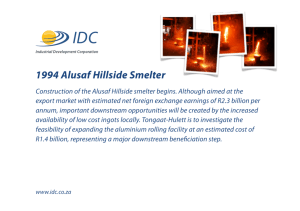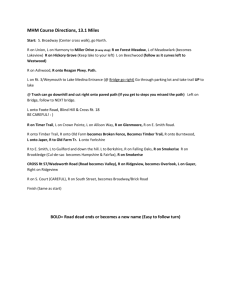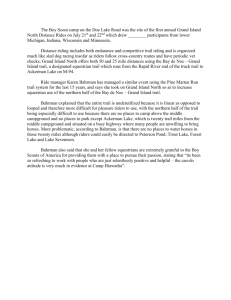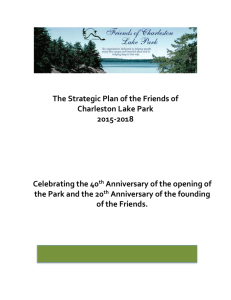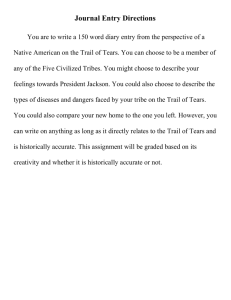ppt
advertisement
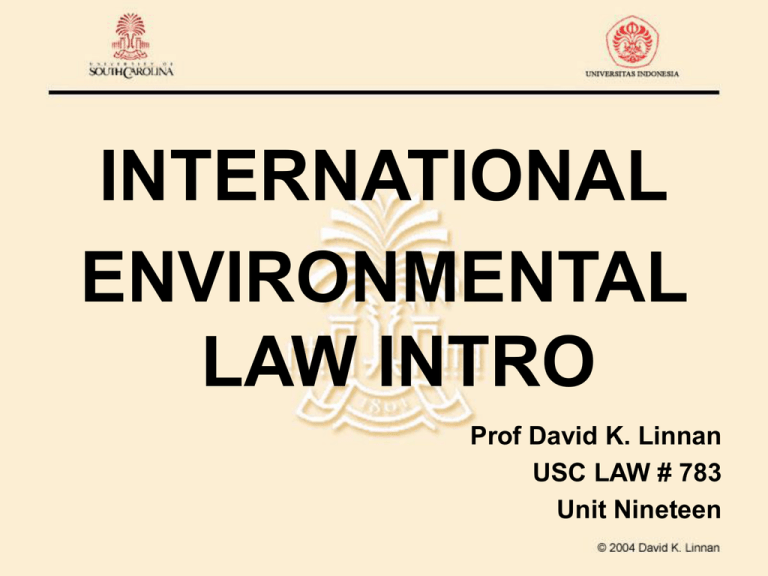
INTERNATIONAL ENVIRONMENTAL LAW INTRO Prof David K. Linnan USC LAW # 783 Unit Nineteen INTRODUCTION BACKGROUND 1. Domestic environmental law itself creation of 1960s-1970s, int’l environmental law customarily dated from 1972 Stockholm Declaration 2. Historical tradition of conservationists vs ecologists later on, is there a difference now in ecosystem focus? 3. Int’l environmental law links closely into economic tradeoff questions (jobs vs environment) STATE DIFFERENCES BACKGROUND (CONT’D) 4. Traditionally, differences in state views a. Typically, richer states tend to be greener and poorer states wish to become richer first b. Now legally vague concept of sustainable development c. State views visible in how law is made, trade-offs in treaty negotiations & overlap between trade & environmental law PLAYERS BACKGROUND (CONT’D) 5. Players a. Currently intellectual claims often entwined with human & indigenous rights analysis via NGOs (plus UN-type meetings, e.g., Rio 1992 & Johannesburg 2002) b. Pursued seriously at government level via treaty level via LOS 1982 and now for example global climate change framework negotiations (Kyoto protocol) MAKING LAW? BACKGROUND (CONT’D) 6. Issues re how law is made vs substantive rules themselves a. Customary law slow in face of challenges b. Issues re general principles & soft law approaches c. Treaty speedy, but substance? i. Package deal approach ii. Framework approach UNDERLYING CONCEPTS I CONCEPTUAL REVIEW Concept of sovereignty buried in traditional public int’l law Bearing on how you make law, and what is default rule (everything not forbidden is permitted vs. everything not permitted is forbidden) UNDERLYING CONCEPTS II CONCEPTUAL REVIEW (CONT’D) Customary law requires consistent practice over a period of time and opinio juris [vs. treaty vs. general principles, soft law too in background] RE CUSTOMARY LAW, WHAT ARE SUBSTANTIVE RULES AND IS IT WELL SUITED TO MAKING NEW LAW IN RAPIDLY CHANGING WORLD? STOCKHOLM DECLARATION BASIC STOCKHOLM (1972) 1. What kind of law (source) seems behind 1972 Stockholm Declaration? 2. Conceptual focus (human development) 3. View of sovereignty implicit in Stockholm Declaration? NOTE CUSTOMARY LAW VINTAGES, NAMELY TRAIL SMELTER (1935), LAKE LANOUX (1957), NUCLEAR TEST CASES (1973) TRAIL SMELTER I TRAIL SMELTER (1935) Smelter built in Canada just across border from US, damage in US from highly polluted emissions blowing across border How would you compare situation to modern problem of Midwestern utilities burning high sulfur coal, acidifying Canadian lakes? TRAIL SMELTER II TRAIL SMELTER (1935)(CONT’D) What does arbitral convention itself tell us implicitly? What happened in the Solothurn-Aargau Swiss case factually, and implication for distinguishing between threat and injury in int’l environmental law? TRAIL SMELTER III TRAIL SMELTER (1935)(CONT’D) Do the law students in the class remember Rylands v. Fletcher from first year classes? What is behind the reference to Alabama Arbitration (US v. UK), post Civil War? Sic utere principle, how does it relate to sovereignties? TRAIL SMELTER IV TRAIL SMELTER (1935)(CONT’D) “[N]o State has the right to use or permit the use of its territory in such a manner as to cause injury … in or to the territory of another or the properties or persons therein, when the case is of serious consequence and the injury is established by clear and convincing evidence.” TRAIL SMELTER V TRAIL SMELTER (1935)(CONT’D) How does the Trail Smelter rule look when applied to utilities air pollution and acidification of Canadian lakes? What does proof process look like? TRAIL SMELTER VI TRAIL SMELTER (1935)(CONT’D) How does Trail Smelter rule compare with Principle 21 of Stockholm Declaration? “States have … the responsibility to ensure that activities within their jurisdictions or control do not cause damage to the environment of other States or of areas beyond the limits of national jurisdiction.” LAKE LANOUX I LAKE LANOUX (1957) French electricity company wants to dam river flowing from French Pyrenees into Spain to produce electricity, issue re impact downstream on Spanish agriculture What is the practical difficulty of upstream vs. downstream states/parties in a river/watershed setting? Who decides and how, what to do about fresh water allocation? LAKE LANOUX II LAKE LANOUX (1957)(CONT’D) Is Lake Lanoux about outcome (water use) or process (how you decide on water use)? How do outcome and process relate to sovereignty from the viewpoint of France (upstream) vs. Spain (downstream)? LAKE LANOUX III LAKE LANOUX (1957)(CONT’D) How would you state the Lake Lanoux principle? [disregard arguments about whether intended as treaty interpretation or customary law, like Trail Smelter arguments about whether law between US states and international law simply the same] LAKE LANOUX IV LAKE LANOUX (1957)(CONT’D) 1. “[T]he rule that States may utilize the hydraulic power of international watercourses only on the condition of a prior agreement between the interested States cannot be established as a custom, even less as a general principle of law.” 2. “[A]ccording to the rules of good faith, the upstream State is under the obligation to take into consideration the various interests involved, to seek to give them every satisfaction compatible with the pursuit of its own interests, and to show that in this regard it is genuinely concerned to reconcile the interests of the other riparian State with its own.” LAKE LANOUX V LAKE LANOUX (1957)(CONT’D) Which trumps, process (how you balance interests) or outcome (based on sovereignty views of resource control)? What do you think happens with major international rivers/watersheds and why? LAKE LANOUX VI LAKE LANOUX (1957)(CONT’D) Do you see the Lake Lanoux principles anywhere in the Stockholm Declaration? [Principles 21 first half & 24? But what of Principle 21 second half] NUCLEAR TEST CASES I NUCLEAR TEST CASES (1973) France is conducting atmospheric nuclear tests on its remote Pacific colony Muroroa Atoll not unlike US tests on Bikini Atoll late 1950s (just before moving them underground), Australia is downwind and complains basically that the nuclear fall-out all blows downwind into Australia so France cannot explode nuclear device on its territory (prior restraint claim) How does that relate to views of sovereignty expressed in Trail Smelter and Lake Lanoux? What is the view of injury compared to Trail Smelter looking at radioactive fall-out? NUCLEAR TEST CASES II NUCLEAR TEST CASES (1973)(CONT’D) What is the view expressed by IgnacioPinto? [hierarchy of sovereignties a possibility, and what is the import for prior restraints vs. damages?] NUCLEAR TEST CASES III NUCLEAR TEST CASES (1973)(CONT’D) What is the view of Judge Ketron? [issue of what is the law and what do you do about rules in process of formation, with analogy to int’l environmental law vs. political and legal distinctions– ultimately asks how states behave] NUCLEAR TEST CASES IV NUCLEAR TEST CASES (1973)(CONT’D) What is the view of Judge De Castro? [why again the issue of political domain vs. int’l law domain, and why the sic utere tuo non laedas principle with Trail Smelter cite, but leaves open damages issue for proof] NUCLEAR TEST CASES V NUCLEAR TEST CASES (1973)(CONT’D) What is the idea of injury in Nuclear Test Cases vs. in Trail Smelter? [think upping thyroid cancer deaths per 100,000 Australians from 200 to 210 per year as a result of fall-out] NUCLEAR TEST CASES VI NUCLEAR TEST CASES (1973)(CONT’D) What is the view of competing sovereignties compared with Lake Lanoux, and is it reconcilable with process/outcome analysis? CUSTOMARY LAW MAKING LAW, IS CUSTOMARY LAW SUITABLE? 1. Based on analysis of three leading customary law precedents, how well or badly does customary law function in determining int’l environmental law? What else would serve? [Your opinion?] 2. Reread the Stockholm Declaration and ask yourself whether the drafters were familiar with customary law principles, and what reflects that. HOW TO ACCOMMODATE SOVEREIGNTY ISSUES IN THE LAW MAKING PROCESS?
